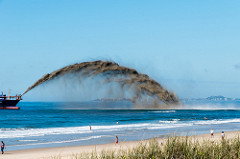Beaches. You love them, I love them, everyone loves them. In fact, 1.5 billion people or about 20% of the worlds population live along them and the coast. And if you don’t live on them you probably enjoy visiting them as they’re huge hot spots for tourists. Beaches are typically very industrialized and booming with infrastructure, meaning high economic value. About 31% of all beaches, not along the arctic poles, are sand beaches. The thing is, these beaches are extremely variable and are constantly changing. In a recent study published by Scientific Reports, a group of researchers found that the majority of sandy beaches around the world are in flux. What this means is that many of the beaches are either eroding away or are in accretion (growing).
Over the course of 30 years (1980-2016), the study found that 24% of the worlds sandy beaches are eroding by more then an average depth of 0.5m/yr a year, that 17% of the worlds sandy beaches are eroding by over a depth of 1m/yr, and that 27% are experiencing accretion rates of over 0.5m/yr. The study found that less then half of the worlds sand beaches are stable (48%), with all the rest changing in size, some at massive rates.
Although it may seem counter intuitive, the private, government protected beaches around the world are the ones most susceptible to erosion. And the highly industrialized, tourist beaches are most commonly undergoing accretion. The reason behind this is almost entirely due to human intervention. For the huge, public tourist ones, governments have been implementing ways in which to manually regrow the beaches. The two main ways this is done is by protecting them with different types of sea walls, concrete structures built to reduce erosion, or by dredging, where offshore boats literally take sand from the ocean and spray it back onto the beach.

The study also found that the two main reasons for beaches eroding was also anthropologically caused. The first being sand mining and subsidence, meaning sand is being mined from shorelines for industrial use. The second being big coastal structures such as harbors and ports causing incoming sediment to the beaches to be blocked off.
The take away; beaches are drastically changing and its mainly in part to humans. Much of the worlds population lies along the coast lines and its important to be informed about what is happening to them. This study was one of the first global studies done in order to show what’s happening to specific sand beaches all over the world as well as explain the reasons behind them. Lastly, the study found that for the most part protected beaches are quickly eroding away, raising cause for serious concern.
Who knows how these rates of change will be affected as sea level continues to rise, for more information about the study visit https://www.nature.com/articles/s41598-018-24630-6 .
Source
Luijendijk, A., et al. 2018. The State of the Worlds Beaches. Scientific Reports 8. 6641: 10-38.










